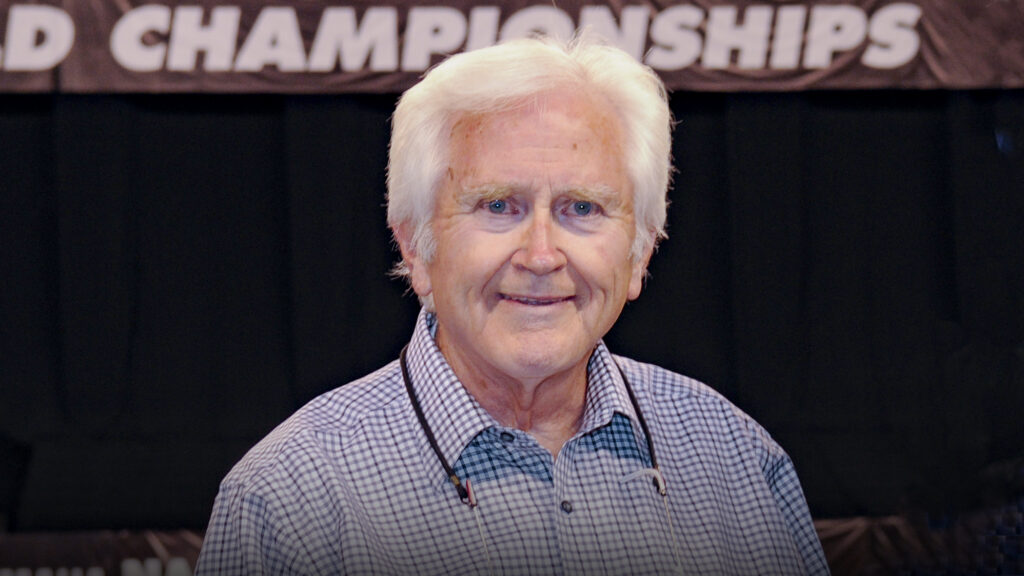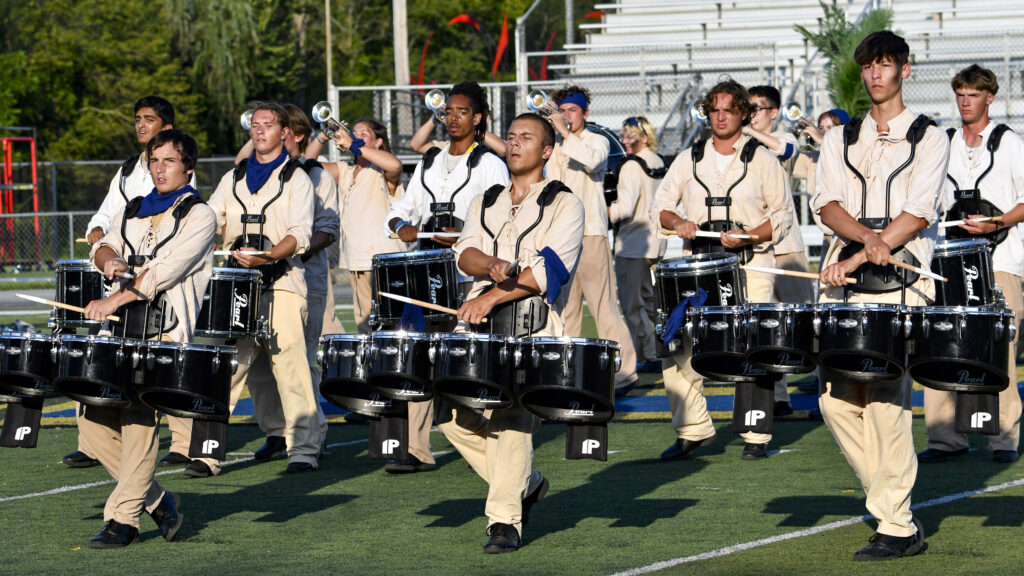In this column, we catch up on some responses to prior columns regarding instruments that once existed on the field in different guises than today.These first two responses are in regards to the Fanfare column of Feb. 25, 2005, “In Praise of Wearing Mallets and Timpani.”
Bruce Lindsey is a postal inspector in Canada. Following are his memories. Geez, my back started to ache after reading that article! I thought I was over that. I carried a timpani between 1971 and 1973 with the Canadian Commanders senior drum corps. I don’t ever recall us being too concerned if they were in tune or not — we tried to tune them before a performance but it never “stuck.”
We would often lend one out to Les Diplomates from Quebec at certain shows. Their lead timpanist was an accomplished musician with a symphony orchestra and he would spend much time tuning it, much to our chagrin. The best memory of lugging the thing around was the wonderful shade it provided when you got to ground it during a drill rehearsal. Being redheaded and fair-skinned, I spent much time crouched in the shade of the drum.
One of the more interesting aspects of marching timps was the individual corps preference to wearing them — some were carried very high at chest level, as 27th Lancers did. We used a contraption of slings and a leg rest on the left leg. I recall Blue Stars had some sort of counterweight arrangement that extended behind them — they looked sort of like a lift bridge when they carried them. The cranks and telescoping legs were also a major pain.
We had shows where cranks would fall off or legs would fall off in the middle of the show. It’s funny now, but it wasn’t so funny then. One of our drum solos featured a four-count timpani roll while the player on the right turned the crank so the tone would go up during the roll. Well, the guy turned the crank the wrong way. Of course, the head looked like the Atlantic Ocean on a rough day. The drum execution judge wasn’t sure what was happening until the cranker grabbed his head with both hands and proclaimed a loud obscenity. Hence our “Song of the Timpani Line” segment was born: “This way up, this way down. Rutabaga, rutabaga, all-the-way-around.” Robert Velarde contributed the following.
I’m one of those first timpani players, dating back to the 1975-1977 Stockton Commodores, 1978 Sacramento Freelancers and the 1979 Santa Clara Vanguard pre-season. I made the auditions but not the commitment. Carrying a timp and marching was not the easiest thing to do. But, it was worth the effort as the ensemble and split parts were a great sound! Wow! I can still hear it backed up with a strong bass line, the snares and trios.
What a sound! Michael Ellerby’s following response is in regards to the Fanfare column of May 13, 2005, <a “#”>”The First Pit Performer and the Birth of the Pit.”
I joined the Kingsmen during the summer of 1969 and stayed with the corps until the fall of 1978. I played snare 1970-1972 and taught and wrote from 1973-1978 and was involved with writing/arranging the “Tubular Bells” solo in the 1974 Kingsmen show. Tom Scheffler, the author of the article about the birth of the pit, made a comment about the 1974 Kingsmen timpani line using gauges to tune. We actually always had gauges on our timpani.
We used masking tape and would mark the pitches before every show, as the letters that were provided with the timpani would move around too much. In 1969, we marched two timpani and a set of marching orchestra bells, except for the VFW show where bells were illegal. So, we marched three timpani there.
In 1970 and 1971 we went with four timpani. We moved up to five timpani in 1972 and continued at that number through 1978. We played a lot of complex parts with a lot of crucial tuning. The players would rely on the pitches being played by the brass players to do the fine-tuning. If there were temperature or humidity changes, they would have to really listen.
Also, the cranking process would move the needle on the gauge slightly out of adjustment. It wasn’t a perfect system. But I am very proud of the playing and tuning of the timpani parts during my run in the Kingsmen, especially some of the breakthrough melodic lines during 1972-1974.
I wrote the entire book in 1973 and shared the responsibility with Donnie Porter in 1974. 1972 was an interesting amalgam of arrangers. I did the snare book and visuals and Ralph Hardimon did the timpani book. Donnie Porter did all the rest of the parts. Of course, we shared and borrowed ideas from each other. It was a fantastic year for the corps and they went on to win the first DCI World Championship ever held.
This final response by Mike “Pee Wee” Hurd follows up on “A Lost Art: The Blue Devils’ French Horn Lines,” the Fanfare column from Jan. 7th, 2005.
I played French horn in the 1989 Santa Clara Vanguard. We were a strong line of eight horns that year, perhaps one of the strongest Vanguard ever had. Phantom Regiment also had a strong French horn line of 10 — 12 horns in 1989 and won the brass caption that year. I feel that the marching — or bell front — French horns best bridged the gap between the trumpet and mellophone sound and that of the upper baritones. It has a lower timbre than the mellophone and a richer sound as well.
I’ve always thought of the marching French horn as an “alto baritone,” if you will. The marching French horn seems to have disappeared from the ranks of the DCI elite corps. At one time, I believe all of DCI’s elite corps were marching with a French horn section. Where have they gone, and why? Well, first of all, the French horn bugle is just as difficult to play as a concert French horn, where any note can be reached on practically any valve combination you happen to press down.
From middle C on up, we could pretty much play any note using any fingering we wanted, and used different combinations to make the note more “in tune” (such as playing middle D open instead of first valve). It was that very same versatility of the French horn that made us rely upon our embouchures 100 percent of the time, which was especially difficult when we were running around on a football field. Keeping a mouthpiece the diameter of a dime on one’s lips while running through potholes and over rocks is no small task. It appears that — ever since the two-valve horns disappeared — it’s been a challenge to find a bell-front French horn that can be played.
I know the Santa Clara Vanguard did attempt to reintroduce French horns into their brass section just a few years ago. Long gone are the days of the two-valve, silver-plated Kings in the key of G. One could play just as fully on those horns as they could on any soprano bugle of the time. There was a time when every top-12 corps had French horns.
I remember seeing them in the Cavaliers, Madison Scouts, Vanguard, Phantom Regiment, Freelancers, Sky Ryders and the Velvet Knights. The ranks of the French horn in drum corps seem to have all but disappeared; yet the orchestral music written for them still continues to be performed on the field. Perhaps someday they’ll emerge to take their proper place in the ranks of the elite again.
Michael Boo has been involved with drum and bugle corps since 1975, when he marched his first of three seasons with the Cavaliers.
He has a bachelor’s degree in music education and a master’s degree in music theory and composition.
He has written about the drum corps activity for over a quarter century for publications such as Drum Corps World, and presently is involved in a variety of projects for Drum Corps International, including souvenir program books, CD liner notes, DCI Update and Web articles, and other endeavors.
Michael currently writes music for a variety of idioms, is a church handbell and vocal choir director, an assistant director of a community band, and a licensed Realtor in the state of Indiana. His other writing projects are for numerous publications, and he has published an honors-winning book on the history of figure skating.
His hobbies include TaeKwonDo and hiking the Indiana Dunes. But more than anything, Michael is proud to love drum corps and to be a part of the activity in some small way, chronicling various facets of each season for the enjoyment of others.





